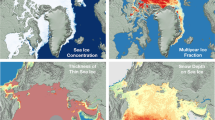Summary
Two split-window strategies for obtaining the actual surface temperature (AST) from an infra-red sensor system are investigated by means of simulations of radiometer signals for a wide range of different geophysical situations. The differences between strategies are closely related to the strong or weak presence of atmospheric effects in the split-window coefficient. It has been demonstrated that the strong presence makes it necessary to know the total atmospheric water vapour as well as the effective emissivities in the two thermal channels for applying the strong split-window method, whereas for the weak presence one only needs to know the emissivities. Simplified algorithms have been obtained from these methods when some of the input data are unknown. Likewise, included for all these algorithms is a rigorous evaluation of their accuracies that takes into account the uncertainties in the emissivity and the noise-equivalent temperature. In this way several algorithms are provided for determining the AST, leaving to the choice of the reader the algorithm that best responds to the required accuracy and the available input data.
Similar content being viewed by others
References
D. Anding andR. Kauth:Remote Sensing Environ.,1, 217 (1970).
C. Prabhakara, G. Dalu andV. G. Kunde:J. Geophys. Res.,79, 5039 (1974).
L. M. McMillian:J. Geophys. Res.,36, 5113 (1975).
P. Y. Deschamps andT. Phulpin:Boundary-Layer Met.,18, 131 (1980).
E. P. McClain, W. G. Pichel andC. C. Walton:J. Geophys. Res. C,6, 11587 (1985).
D. Ho, A. Asem andP. Y. Deschamps:Int. J. Remote Sensing,10, 1323 (1986).
J. C. Price:J. Geophys. Res. D,5, 7231 (1984).
F. Becker andZ. L. Li:Int. J. Remote Sensing,11, 369 (1990).
J. A. Sobrino andV. Caselles:ISPRS J. Photogramm. Remote Sensing, in press (1993).
J. A. Sobrino andV. Caselles:Int. J. Remote Sensing,12, 2461 (1991).
J. A. Sobrino, C. Coll andV. Caselles:Remote Sensing Environ.,38, 19 (1991).
F. X. Kneizys, E. P. Shettle, L. W. Abreu, G. P. Anderson, J. H. Chetwynd, W. O. Gallery, J. E. A. Selby andS. A. Clough:Users guide to LOWTRAN 7, Technical Report AFGL-TR-88-0177, Optical/Infrared Technology Division, US Air Force Geophysics Laboratory, Hanscom Air Force Base, Massachusetts (1988).
C. Prabhakara, G. Dalu, R. C. Lo andN. R. Nath:Mon. Weather Rev.,107, 138 (1979)
A. Chedin, N. A. Scott, N. Husson, J. F. Flobert, C. Levy andP. Moine:J. Quantum Spectrosc. Radiat. Transfer,3, 257 (1988).
D. Chesters, L. W. Uccellini andW. D. Robinson:J. Climate Appl. Met.,22, 725 (1983).
G. Dalu:Int. J. Remote Sensing,7, 1089 (1987).
P. Schluessel:Int. J. Remote Sensing,10, 705 (1988).
T. F. Eck andB. N. Holben:Vertical column precipitable water determinations over terrestrial surfaces from AVHRR thermal channels, inX Annual International Geoscience & Remote Sensing Symposium, Maryland (USA), 20–24 May 1990.
K. J. K. Buettner andC. D. Kern:J. Geophys. Res.,70, 1329 (1965).
F. Becker, F. Nerry, P. Ramanantsizehena andM. P. Stoll:Int. J. Remote Sensing 7, 1751 (1986).
J. W. Salisbury andN. M. Milton:Photogramm. Eng. Remote Sensing,54, 1301 (1988).
J. A. Sobrino andV. Caselles:An Fis. B,85, 220 (1989).
V. Caselles andJ. A. Sobrino:Remote Sensing Environ.,29, 135 (1989)
V. Caselles, J. A. Sobrino andF. Becker:Int. J. Remote Sensing,9, 715 (1988).
J. A. Sobrino andV. Caselles:Remote Sensing Environ.,33, 193 (1990).
J. A. Sobrino, V. Caselles andF. Becker:ISPRS J. Photogramm. Remote Sensing,44, 343 (1990).
V. Caselles andJ. A. Sobrino:Remote Sensing for Hazard Monitoring and Disaster Assessment: Marine and Coastal Applications in the Mediterranean Region, edited byE. C. Barret, K. A. Brown andA. Micallef (Gordon and Breach, London, 1991), p. 139.
Author information
Authors and Affiliations
Rights and permissions
About this article
Cite this article
Sobrino, J.A., Caselles, V. & Coll, C. Theoretical split-window algorithms for determining the actual surface temperature. Il Nuovo Cimento C 16, 219–236 (1993). https://doi.org/10.1007/BF02524225
Received:
Accepted:
Issue Date:
DOI: https://doi.org/10.1007/BF02524225




